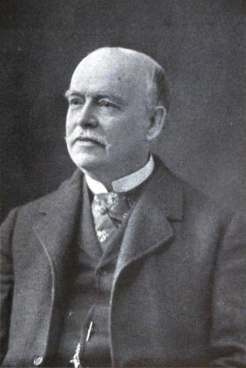
Josiah Cleaveland Cady was an American architect known for his Romanesque Revival designs. He was also a founder of the American Institute of Architects.

The Church of the Intercession is an Episcopal congregation located at 550 West 155th Street, at Broadway, on the border of the Harlem and Washington Heights neighborhoods of Manhattan, New York City, on the grounds of Trinity Church Cemetery. The congregation was founded in 1846, and the current sanctuary, built in 1912–1915, was designed by Bertram Grosvenor Goodhue in the Gothic Revival style. From 1906–1976, it was a chapel of Trinity Church.
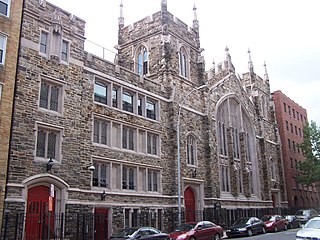
The Abyssinian Baptist Church is a Baptist megachurch located at 132 West 138th Street between Adam Clayton Powell Jr. Boulevard and Lenox Avenue in the Harlem neighborhood of Manhattan, New York City. It is affiliated with the National Baptist Convention, USA and American Baptist Churches USA.

Grace Church is a historic parish church in Manhattan, New York City which is part of the Episcopal Diocese of New York. The church is located at 800–804 Broadway, at the corner of East 10th Street, where Broadway bends to the south-southeast, bringing it in alignment with the avenues in Manhattan's grid. Grace Church School and the church houses—which are now used by the school—are located to the east at 86–98 Fourth Avenue between East 10th and 12th Streets. In 2021, it reported 1,038 members, average attendance of 212, and $1,034,712 in plate and pledge income.

The Church of Saint Mary the Virgin is an Episcopal Anglo-Catholic church in Midtown Manhattan, New York City, which is part of the Episcopal Diocese of New York of the Episcopal Church in the United States of America. The church complex is located in the heart of Times Square at 133-145 West 46th Street, with other buildings of the complex at 136-144 West 47th Street, between Sixth and Seventh Avenues. It is colloquially known as "Smoky Mary's" because of the amount of incense used in the services.

The Harlem YMCA is located at 180 West 135th Street between Lenox Avenue and Adam Clayton Powell Jr. Boulevard in the Harlem neighborhood of Manhattan, New York City. Built in 1931-32, the red-brown brick building with neo-Georgian details was designed by the Architectural Bureau of the National Council of the YMCA, with James C. Mackenzie Jr. as the architect in charge. It replaced the building from 1919 across the street. Inside the building is a mural by Aaron Douglas titled "Evolution of Negro Dance." The building was declared a National Historic Landmark in 1976, and was designated a New York City Landmark in 1998.
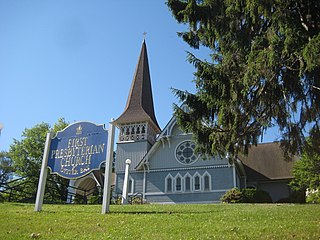
First Presbyterian Church built in 1873 is classified as an historic Stick/Eastlake style Presbyterian Church building located at 60 East Main Street in Oyster Bay, in the U.S. state of New York. Its architect was J. Cleaveland Cady, who was just beginning his career and would go on to design the original Metropolitan Opera House, the American Museum of Natural History, buildings at Yale University, Trinity College, and 23 other churches including the Plantsville Congregational Church, Southington, CT in the similar Gothic Revival style.

St. Cecilia Church is a Roman Catholic parish church in the Roman Catholic Archdiocese of New York and a historic landmark located at 120 East 106th Street between Park Avenue and Lexington Avenue, Manhattan, New York City, New York. The parish was established in 1873. It was staffed by the Redemptorist Fathers from 1939 to 2007. The church was designated a New York City landmark in 1976. The church and convent were listed on the U.S. National Register of Historic Places in 1984.
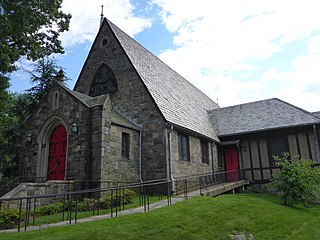
Riverdale Presbyterian Church is a historic Presbyterian church located at 4761-4765 Henry Hudson Parkway in the Riverdale neighborhood of the Bronx, New York City. It was designed in 1863 by architect James Renwick Jr. The church is a fieldstone building in an English-inspired Late Gothic Revival style. It was substantially enlarged in 1936.

St. Ann’s Church was the name of a former Roman Catholic parish church at 110-120 East 12th Street between Fourth and Third Avenues in the East Village neighborhood of Manhattan, New York City.

The Church of the Transfiguration is a Roman Catholic parish located at 25 Mott Street on the northwest corner of Mosco Street in the Chinatown neighborhood of Manhattan, New York City. The parish is under the authority of the Archdiocese of New York and is staffed by the Maryknoll order.

St. Philip's Episcopal Church is a historic Episcopal church located at 204 West 134th Street, between Adam Clayton Powell Jr. Boulevard and Frederick Douglass Boulevard in the Harlem neighborhood of Manhattan, New York City. Its congregation was founded in 1809 by free African Americans worshiping at Trinity Church, Wall Street as the Free African Church of St. Philip. First located in the notorious Five Points neighborhood, it is the oldest black Episcopal parish in New York City. Historically, it was extremely influential both while located in lower Manhattan and as an institution in Harlem, and many of its members have been leaders in the black community. In 2020, it reported 188 members, 111 average attendance, and plate and pledge income of $224,827.
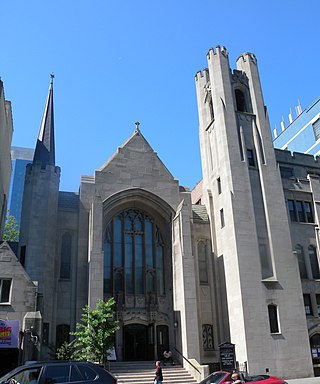
Saint Luke's Lutheran Church, once known as The German Evangelical Lutheran Saint Luke's Church, is a historic Lutheran church located on Restaurant Row at 308 West 46th Street between Eighth and Ninth Avenues in the Theater District of Manhattan, New York City.

The St. Aloysius Catholic Church is a Catholic parish in the Archdiocese of New York, located at 209-217 West 132nd Street between Adam Clayton Powell Jr. Boulevard and Frederick Douglass Boulevard in the Harlem neighborhood of Manhattan, New York City.

The Albemarle–Kenmore Terraces Historic District is a small historic district located in the Flatbush neighborhood of Brooklyn, New York City. It consists of two short cul-de-sacs, Albemarle Terrace and Kenmore Terrace, off of East 21st Street, and the 32 houses on the two streets, as well as a four-family apartment building at the end of Albemarle Terrace. The New York City Landmarks Preservation Commission, which designated the district as a landmark in 1978, noted that the "terraces are distinguished by the uniform use of materials, height and color producing a harmonious effect".

The First Presbyterian Church, known as "Old First", is a church located at 48 Fifth Avenue between West 11th and 12th Streets in the Greenwich Village neighborhood of Manhattan, New York City. It was built in 1844–1846, and designed by Joseph C. Wells in the Gothic Revival style. The south transept of the building was added in 1893–1894, and was designed by the firm of McKim, Mead & White. The church complex, which includes a parish house – now referred to as the "South Wing" – on West 11th Street and a church house on West 12th Street designed by Edgar Tafel, is located within the Greenwich Village Historic District.
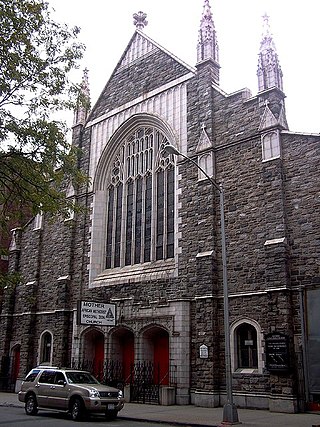
The Mother African Methodist Episcopal Zion Church, also known as "Mother Zion", located at 140–148 West 137th Street between Adam Clayton Powell Jr. Boulevard and Lenox Avenue in the Harlem neighborhood of Manhattan, New York City, is the oldest African-American church in New York City, and the "mother church" of the African Methodist Episcopal Zion conference.

Joseph Collins Wells (1814–1860) was an English-born architect who practiced in New York City from 1839 to 1860. He was a founding member of the American Institute of Architects, and several of his works have been listed on the National Register of Historic Places. Two of his works, the Henry C. Bowen House and the Jonathan Sturges House, have been designated as U.S. National Historic Landmarks. He also designed First Presbyterian Church, a New York City Landmark in Greenwich Village.
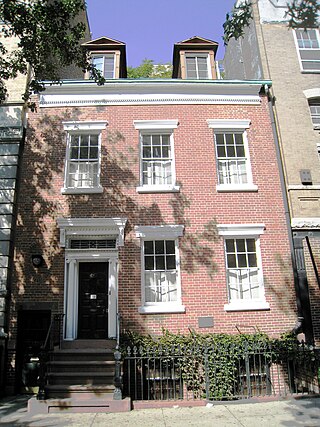
Charles Street is a street in the West Village neighborhood of Manhattan in New York City. It runs east to west from Greenwich Avenue to West Street. The street was named after Charles Christopher Amos, who owned the parcel the street passed through. Amos is also the namesake of Christopher Street, two blocks to the south, and the former Amos Street, which is now West 10th Street. Charles Lane is a one-block alley located between Charles and Perry Streets and Washington and West Streets. From 1866 to 1936, the section of Charles Street between Bleecker Street and West 4th Street was called Van Ness Place after a farm, owned by the Van Ness family, which had occupied the square bounded by Bleecker, West 4th, Charles and Perry Streets until 1865.
























